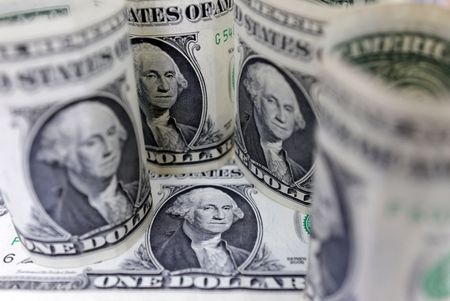By Rae Wee
SINGAPORE (Reuters) -The dollar fell in tandem with U.S. Treasury yields on Friday after downside surprises on U.S. economic data this week cemented bets of more Federal Reserve rate cuts this year.
The week started out with a mix of market tailwinds headlined by a U.S.-China trade truce which propelled the dollar higher, though the euphoria soon fizzled out and left currencies trading sideways.
Most of the action in the foreign exchange market came from the dollar’s moves against the South Korean won, where it fell sharply for a second straight day on news that Washington and Seoul discussed the dollar/won market earlier this month.
The moves were reminiscent of a similar episode in the Taiwan dollar earlier this month.
The dollar last traded 0.4% lower at 1,390 won.
“Speculation is once again mounting that President Trump favours a weaker dollar, potentially pressuring other governments to allow their currencies to appreciate in trade negotiations,” said George Vessey, lead FX and macro strategist at Convera.
“Asian currency weakness against the dollar has long been seen as an advantage for regional exporters, a stance the administration has sought to challenge.”
In the broader market, the dollar was struggling to regain its footing after an overnight slide following data which showed U.S. producer prices unexpectedly fell in April.
The PPI figures came on the heels of a tame consumer price reading earlier in the week, cementing bets that the Fed is likely to cut rates at least twice this year.
The euro was up 0.26% to $1.2130 while sterling rose 0.14% to $1.3325.
Against a basket of currencies, the dollar fell 0.2% to 100.57, though was on track for a slight weekly gain thanks to its sharp 1.3% rise on Monday.
Markets are now pricing in roughly 57 basis points worth of Fed cuts by December following Thursday’s data, up from 49 bps previously.
The benchmark 10-year U.S. Treasury yield extended its 7 bps drop from overnight and was last a touch lower at 4.4217%. The two-year yield fell to 3.9467%.
In a closely watched speech on Thursday, Fed Chair Jerome Powell said policymakers feel they need to reconsider the key elements around both jobs and inflation in their current approach to monetary policy.
“Chair Powell said that the FOMC will be placing more weight on the inflation outlook than on employment when setting monetary policy following a monetary policy framework review. This suggests a potentially higher hurdle to Fed cuts if inflation risks remain to the upside,” said Kristina Clifton, senior currency strategist at Commonwealth Bank of Australia.
“We forecast three FOMC interest rate cuts this year. But the risks lie towards less cuts if inflation picks up.”
Elsewhere, the dollar was down 0.33% against the yen at 145.30, in line with the broader market, despite Friday’s downbeat GDP data in Japan and dovish remarks from a Bank of Japan policymaker.
“The data…adds to the stress on optimism as Japan braces for the impact of tariffs. We expect a reasonable deal with the U.S. in the coming months which should alleviate the impact,” said Krishna Bhimavarapu, APAC economist at State Street Global Advisors.
“All this will mean that the Bank of Japan will comfortably sit on the sidelines till certainty emerges as we expect just one hike this year, perhaps in Q4.”
Investors also had their eye on potential talks between Tokyo and Washington next week, where Japanese Finance Minister Katsunobu Kato said he would seek to discuss foreign exchange issues with U.S. Treasury Secretary Scott Bessent.
In Australia, the Aussie rose 0.39% to $0.6430, while the New Zealand dollar gained 0.6% to $0.5910.
(Reporting by Rae Wee; Editing by Lincoln Feast.)










